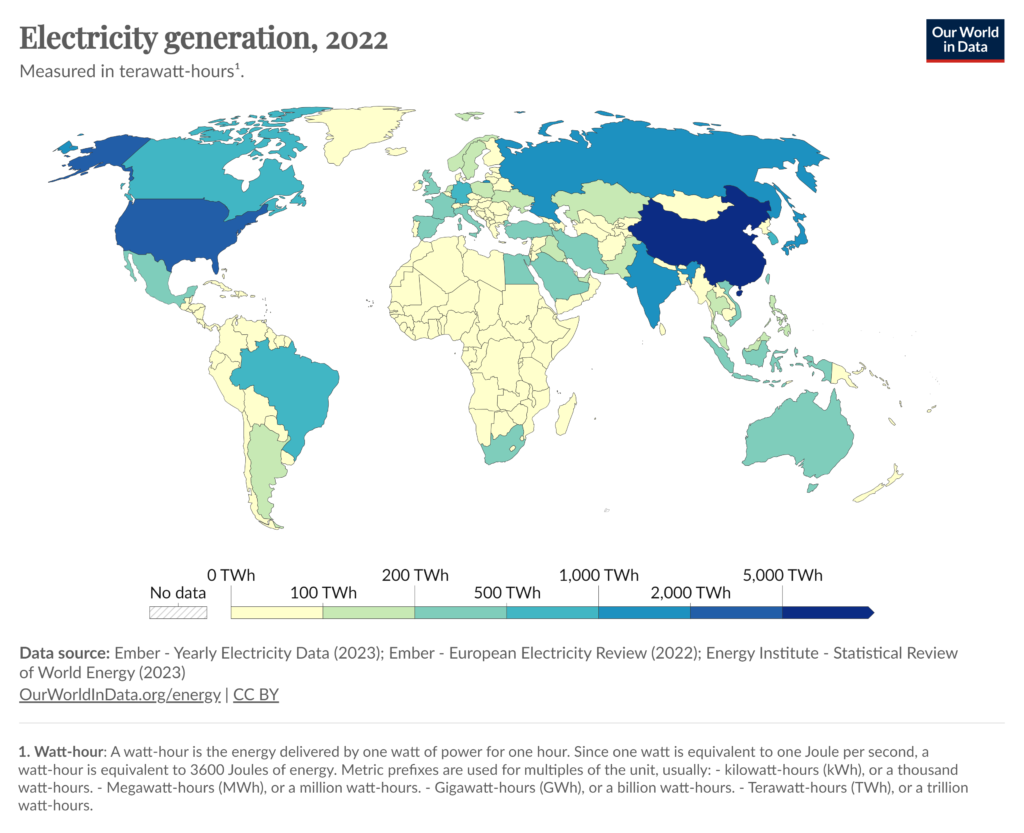
Powering the Future: A Close Look at Electricity Trends in Saudi Arabia, Jordan and Beyond
In an era where the balance between energy demand and supply is a critical indicator of a country’s energy sustainability and efficiency, examining electricity demand and generation across different nations reveals varied pictures of energy health and policy effectiveness. This post will explore key figures related to electricity demand and generation in Saudi Arabia, Jordan, and compare them with other countries, including the global perspective.

Global Energy Landscape
At a global scale, electricity demand and generation stand exactly in equilibrium, with both figures reported at 28,660.98 terawatt-hours (TW). This balance is an ideal scenario, indicating that, on a worldwide basis, electricity production meets the demand efficiently. However, this macro-level view masks the disparities present at the country level.
United States: The Energy Behemoth
The United States, one of the largest consumers of electricity, showcases a demand of 4,328.12 TW against a generation of 4,286.91 TW. The slight deficit (represented as 0.95% below demand) underscores challenges even developed nations face in perfectly matching energy generation with demand.
Saudi Arabia: Striding Towards Balance
Saudi Arabia, a key player in the global energy market, presents an interesting case. With an electricity demand of 401.29 TW and a generation capacity of 401.59 TW, the country slightly exceeds its demand by 0.07%. This overage is a positive indicator of Saudi Arabia’s efforts to not just meet, but exceed its electricity needs, reflecting perhaps on its broader energy diversification strategies.
Jordan: The Challenge of Meeting Demand
Jordan, with smaller scale figures, has an electricity demand of 22 TW and a generation of 21.86 TW, reflecting a shortfall of 0.64%. While seemingly minor, this gap points to the challenges smaller nations face in energy generation, heavily impacted by resources, infrastructure, and geopolitical factors.
Contrasts in the Mediterranean: Italy and Spain
Italy and Spain offer contrasting narratives. Italy faces a significant shortfall, with demand at 327.72 TW and generation at only 284.73 TW, a deficit of 13.12%. Spain, conversely, has managed to turn the tide, generating 285.16 TW against a demand of 265.36 TW, achieving a surplus of 7.46%. These figures underscore the impact of national energy policies and investment in renewable sources.
Egypt: The Balance in the Nile Valley
Egypt closely aligns its generation with demand, with figures at 207.28 TW and 208.10 TW, respectively, indicating a slight surplus of 0.40%. This balance is crucial for the country’s economic stability and development ambitions.
Understanding TW – Terawatt
Before delving into the data, it’s crucial to clarify that TW stands for Terawatt, a unit of power equivalent to one trillion (10^12) watts. Terawatt hours (TWh) measure the total energy consumed or generated over a period, providing a scale to gauge the vast energy systems that power our world.
Here’s a table that not only showcases electricity demand and generation but also integrates population figures for a comprehensive understanding. Population data is sourced from the latest United Nations estimates.
| Country | Electricity Demand (TW) | Electricity Generation (TW) | Production vs. Demand | Population (2023 Estimates) |
| World | 28,660.98 | 28,660.98 | – | 7.9 Billion |
| United States | 4,328.12 | 4,286.91 | -0.95 | 331 Million |
| Saudi Arabia | 401.29 | 401.59 | 0.07 | 35 Million |
| Turkey | 328.81 | 326.11 | -0.82 | 84 Million |
| Italy | 327.72 | 284.73 | -13.12 | 60 Million |
| Spain | 265.36 | 285.16 | 7.46 | 47 Million |
| Egypt | 207.28 | 208.1 | 0.4 | 102 Million |
| Jordan | 22 | 21.86 | -0.64 | 10 Million |
Data Source Acknowledgment
The electricity demand and generation figures have been sourced from ourworldindata.org, a reputable platform for global statistics and insights. This data provides a lens through which we can assess and understand the energy dynamics of different countries.
Insights and Implications
The interplay between electricity demand, generation, and population gives rise to intricate narratives across the globe. While the World maintains an equilibrium, individual countries exhibit varying degrees of surplus or deficit, reflecting the complexities of managing energy resources. Saudi Arabia and Spain’s slight energy surpluses juxtapose sharply against Italy’s notable deficit, underscoring the diverse challenges and achievements in national energy policies.
Countries like Jordan and Egypt, with their close alignment of demand and generation, showcase the nuanced balance smaller nations strive for amid fluctuating resources and growing populations. These statistics not only highlight the current state of energy affairs but also point towards future trajectories as nations evolve towards greener energy solutions and strive for energy independence.
The Path Forward
These figures invite reflection on the global shift towards renewable energy, the potential for technological innovations, and the critical importance of energy policy in shaping the future of our planet’s energy landscape. As countries navigate their unique energy challenges, the collective journey towards sustainability and efficiency in energy usage becomes all the more pertinent.

